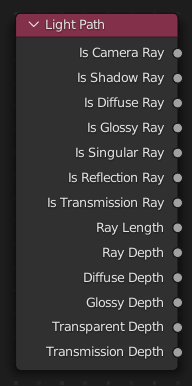Light Path Node¶

The Light Path node is used to find out for which kind of incoming ray the shader is being executed; particularly useful for non-physically-based tricks. More information about the meaning of each type is in the Light Paths documentation.
Inputs¶
This node has no inputs.
Properties¶
This node has no properties.
Outputs¶
- Is Camera Ray
1.0 if shading is executed for a camera ray, otherwise 0.0.
- Is Shadow Ray
1.0 if shading is executed for a shadow ray, otherwise 0.0.
- Is Diffuse Ray
1.0 if shading is executed for a diffuse ray, otherwise 0.0.
- Is Glossy Ray
1.0 if shading is executed for a glossy ray, otherwise 0.0.
- Is Singular Ray Cycles Only
1.0 if shading is executed for a singular ray, otherwise 0.0.
- Is Reflection Ray Cycles Only
1.0 if shading is executed for a reflection ray, otherwise 0.0.
- Is Transmission Ray Cycles Only
1.0 if shading is executed for a transmission ray, otherwise 0.0.
- Ray Length Cycles Only
Distance traveled by the light ray from the last bounce or camera.
- Ray Depth
Number of times the ray has been reflected or transmitted on interaction with a surface.
Note
Passing through a transparent shader does not count as a normal “bounce”.
- Diffuse Depth Cycles Only
Number of times the ray has gone through diffuse reflection or transmission.
- Glossy Depth Cycles Only
Number of times the ray has gone through glossy reflection or transmission.
- Transparent Depth Cycles Only
Number of times the ray has gone through a transparent surface.
- Transmission Depth Cycles Only
Number of times the ray has gone through a transmissive surface. A typical use case is to avoid black spots in the render (caused by rays hitting the bounce limit) by switching from a transmissive to a diffuse shader past a certain point. See Mix Shader.
EEVEE Support¶
EEVEE has no real concept of rays, but in order to ease the workflow between Cycles and EEVEE, some of the outputs are supported in particular cases.
Is Camera: Supported.
Is Shadow: Supported.
Is Diffuse: Supported.
Is Glossy: Supported.
Is Singular: Not supported. Same as Is Glossy.
Is Reflection: Not supported. Same as Is Glossy.
Is Transmission: Not supported. Same as Is Glossy.
Ray Length: Distance from the camera to the shading point.
Ray Depth: Indicates the current bounce when baking the light cache.
Diffuse Depth: Same as Ray Depth but only when baking diffuse light.
Glossy Depth: Same as Ray Depth but only when baking specular light.
Transparent Depth: Not supported. Defaults to 0.
Transmission Depth: Not supported. Same as Glossy Depth.
Note
Is Glossy does not work with Screen Space Reflections/Refractions but does work with reflection planes (whether used with SSR or not).